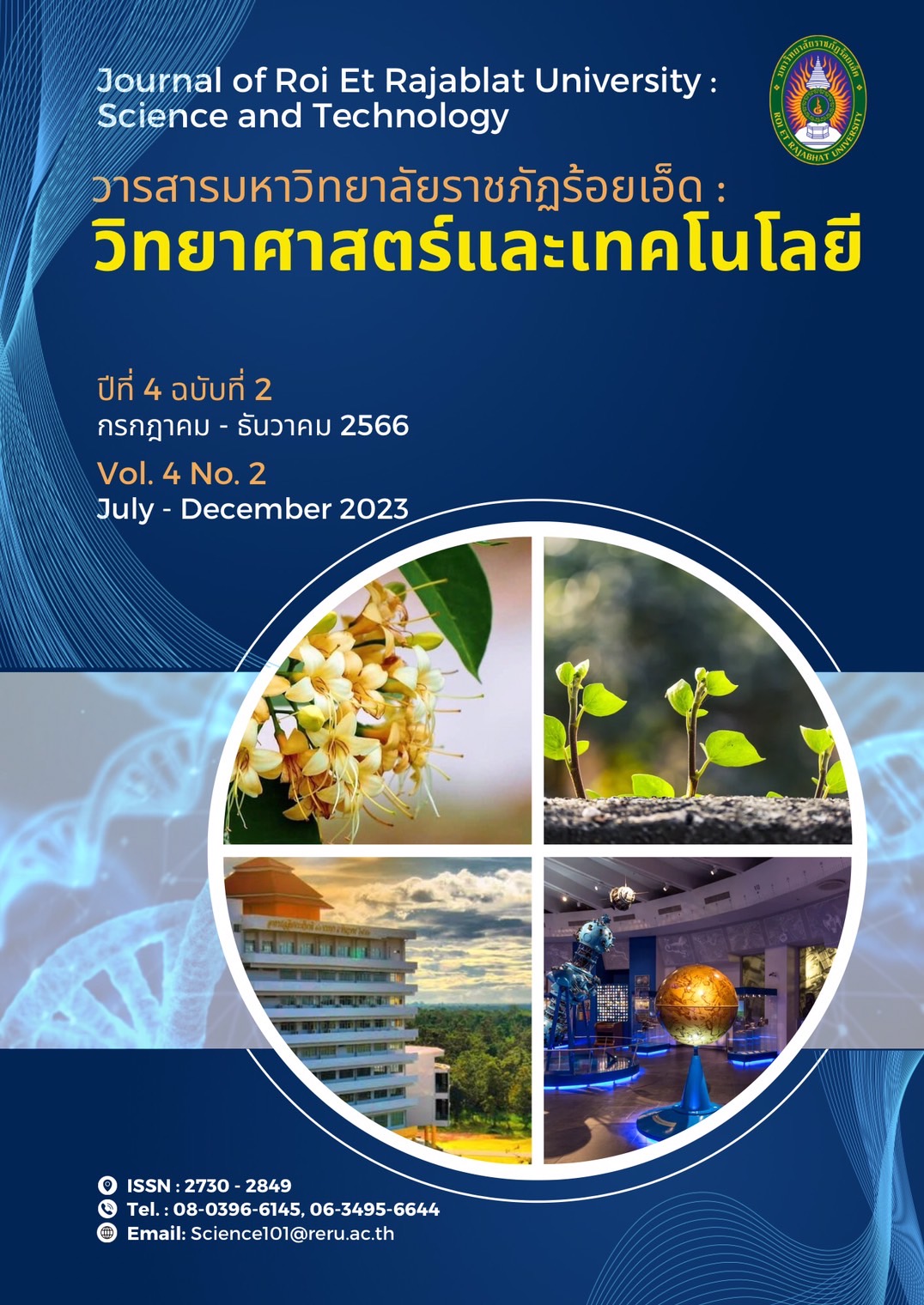Larvicidal Activity of Herb Plants Extracts Against House Fly Larvae (Musca domestica L.)
บทคัดย่อ
The efficacy of herbal plants in controlling the house fly (Musca domestica L.) was determined. A comparison of the effectiveness of 7 herbal plants (tobacco leaf, basil leaf, nontai yak, siam weed leaf, kariyat, common basil leaf and sugar apple leaf) were extracted with water and 70% ethanol (10% (w/v) of concentration). The tested for efficiency of controlling larvae of house fly by mixed with diet of house fly compared with Commercial Neem extract (Sadao Thai No.111®). Completely Randomize Design (CRD) was arranged in the experiment. After 24 hours of test, the extraction of tobacco leaves with water (86.67%) and 70% ethanol (100%) had non-significantly differed (P>0.05) with commercial neem extract (control) (100%), followed by Siam weed leaf extract for 25.45 and 46.46% for extracted with water and 70% ethanol, respectively. The LC50 values of commercial neem extract and tobacco leaf extract were 0.0107 and 0.107%, respectively. The tobacco leaf extraction had the most effectiveness in controlling house fly larvae. This can be further used to control house fly in greenhouse.
References
คม สุคนธสรรพ์ และ กาบแก้ว สุคนธสรรพ์. (2538). แมลงที่มีความสำคัญทางการแพทย์ของประเทศไทย (เล่มที่ 1). เชียงใหม่: เชียงใหม่ดิจิตอลเวิร์ค จำกัด.
เดือนเพ็ญ วงค์สอน และ ศุภปริญญา รสกระโทก. (2565). การคัดเลือกเชื้อราก่อโรคแมลงไอโซเลตจังหวัดนครราชสีมาที่มี ประสิทธิภาพในการเข้าทำลายหนอนและดักแด้แมลงวันบ้าน (Musca domestica L.). วารสารแก่นเกษตร, 50(3), 830 – 842.
สำนักวิจัยวิทยาศาสตร์และสาธารณสุข. (2553). ชีววิทยาและการควบคุมแมลงที่เป็นปัญหาสาธารณสุข. นนทบุรี: บริษัทหนังสือดีวันจำกัด.
อาคม สังข์วรานนท์. (2543). กีฏวิทยาทางสัตวแพทย์. กรุงเทพฯ: โรงพิมพ์สหมิตรพริ้นติ้ง.
Abdel., M., Abdel, R. and Razik, M.A. (2017). Toxicological and development effects of selected insecticides, plant extracts on house fly, Musca domestica L. Journal of Biochemistry. 7: 127-137.
Acevedo, G. R., Zapater, M. and Toloza, A.C. (2009). Insecticide resistance of house fly, Musca domestica (L.) from Argentina. Parasitology Research. 105: 489-493.
Ahmed, K.M. (2018). The effect of aqueous plant extracts of tobacco on Third larvae of house fly (Musca domestica L., (Diptera: Muscide). Journal of Entomology and Zoology Studies. 6(3): 403-408.
Ahmed, S., Khan, A.S., Nisar, M.S. and Shakir, M.M. (2015). Effect of aqueous extracts of different plants on life cycle and population build up parameters of house fly, Musca domestica L. (Diptera: Muscidae). Research & Reviews: Journal of Agriculture Science and Technology. 4(1): 1-6.
Azzam, S.and Hussein, E. (2002). Toxicities of several insecticides to the house fly Musca domestica from different regions in Jordon. Sarhad Journal of Agriculture. 18: 69–75.
Charles, J.G. (2004). Mealybug insecticide resistance management strategy. New Zealand Plant Protection Society (Incorporated). Available: https://resistance.nzpps.org/index.php?p=insecticides/mealybug. Accessed Jul. 9, 2020.
Degu, S., Berihun, A., Muluye, R., Gemeda, H., Debebe, E., Amano, A., Abebe, A., Woldkidan, S. and Tadele, A. (2020). Medicinal plants that used as repellent, insecticide and larvicide in Ethiopia. Pharmacy & Pharmacology International Journal. 8(5): 274-283.
Geden, C.J. Nayduch, D., Scott, J.D., Burgess, E.R., Gerry, A.C., Kaufman, P.E., Thomson, J., Pickens, V.and Machtinger, E.T. (2021). House fly (Diptera: Muscidae): biology, pest status, current management prospects, and research needs. Journal of Integrated Pest Management. 12(1): 1–38.
Iqbal, W., Malik, M.F., Sarwar, M.K., Azam, I., Iram, N.and Rashda, A. (2014). Role of house fly (Musca domestica, Diptera: Muscidae) as a disease vector; a review. Journal of Entomology and Zoology Studies. 2(2): 159-163.
Jesikha, M. (2012). Evaluation of larvicidal efficacy of aloe vera extract against Musca Domestica. Journal of Environmental Science. Toxicology and Food Technology. 2(2): 1-3.
Khan, M.F. and Ahmed, S.M. (2000). Toxicity of crude neem leaf extract against housefly (Musca domestica L.) adults as compared with DDVP, dichlovos. Turkish Journal of Zoology. 24: 219-223.
Merdan, B.A. (2012). Bacillus thuringiensis as a feed additive to control Musca domestica associated with poultry house. The Journal of Basic & Applied Zoology. 65: 83-87.
Mostafa, A.A. and Zayed, A.B. (1999). Resistance of Musca domestica (L) (Diptera: Muscidae) from Gamsa City to some insecticides. Egyptian Society of Parasitology. 29: 193–201.
Ogbalu, O.K. Bobmanuel, R.B. and Membere, O. (2014). Larvicidal effect of aqueous leaf extract of tobacco (Nicotiana tabacum) on the third instar larvae of Musca domestica. IOSR-JAVS. 7: 35-40.
Rahman, S., Biswas, S.K., Barman, N.C. and Ferdous, T. (2016). Plant extract as selective pesticide for integrated pest management. Biotechnological Research. (1): 6-10.
Sharififard, M, Mossadegh, M.S., Vazirianzadhe, B. and Mahmoudabadi, A.Z. (2011). Laboratory pathogenicity of entomopathogenic fungi, Beauveria bassiana (Bals.) Vuill. and Metarhizium anisoplae (Metch.) Sorok. to larvae and adult of house fly, Musca domestica L. (Diptera: Muscidae). Asian Journal of Biological Sciences. 4: 128–137.
Zoubiri, S. and Baaliouamer, A. (2014). Potentiality of plants as source of insecticide principles. Journal of Saudi Chemical Society. 18: 925 – 938.
Downloads
เผยแพร่แล้ว
How to Cite
ฉบับ
บท
License
Copyright (c) 2023 คณะศิลปศาสตร์และวิทยาศาสตร์ มหาวิทยาลัยราชภัฏร้อยเอ็ด

This work is licensed under a Creative Commons Attribution-NonCommercial-NoDerivatives 4.0 International License.
บทความที่ได้รับการตีพิมพ์เป็นลิขสิทธิ์ของคณะศิลปศาสตร์และวิทยาศาสตร์ มหาวิทยาลัยราชภัฏร้อยเอ็ด
ข้อความที่ปรากฏในบทความแต่ละเรื่องในวารสารวิชาการเล่มนี้เป็นความคิดเห็นส่วนตัวของผู้เขียนแต่ละท่านไม่เกี่ยวข้องกับมหาวิทยาลัยราชภัฎร้อยเอ็ด และคณาจารย์ท่านอื่นๆในมหาวิทยาลัยฯ แต่อย่างใด ความรับผิดชอบองค์ประกอบทั้งหมดของบทความแต่ละเรื่องเป็นของผู้เขียนแต่ละท่าน หากมีความผิดพลาดใดๆ ผู้เขียนแต่ละท่านจะรับผิดชอบบทความของตนเองแต่ผู้เดียว





